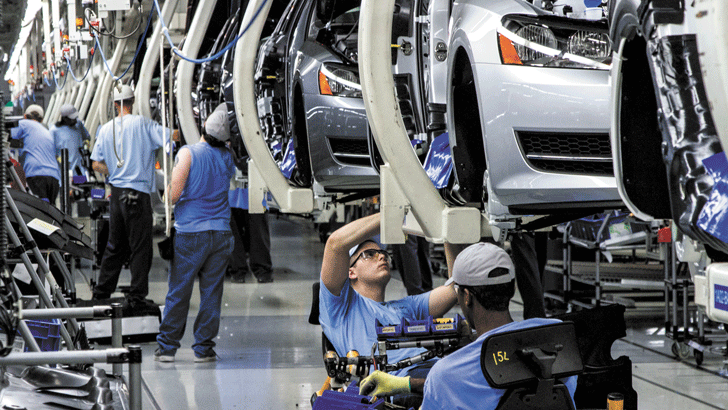Union lessons from the U.S. auto industry

In a closely-watched election, the United Autoworkers Union (UAW) recently attempted to break into the anti-union South to organise a Volkswagen plant in Chattanooga, Tennessee.
The union lost the election in February among the plant’s 1,550 production workers, with 626 votes in favour and 712 against.
Outside interference played a significant role in the election.
Public statements by the Republican Governor, Republican state legislative majority leader, and US Senator Bob Corker from Tennessee warned workers that if they voted for the union, the state would cut back on subsidies to the factory, and that Volkswagen would move production of its new SUV elsewhere.
Lower-level management violated a “neutrality” agreement, and mobilised white collar workers to campaign for a No vote. Extreme right groups also poured money into the anti-union campaign.
But the UAW leadership was the main factor in the defeat. They were in bed with the company. This turned off many workers.
According to an article by Neil Young in the pro-union In These Times, the UAW agreed not to bargain for wages above what was offered by Volkswagen competitors in the US. The UAW and Volkswagen agreed to “maintaining and where possible enhancing the cost advantages and other competitive advantages that [Volkswagen] enjoys relative to its competitors.”
The workers had no say in any of this, which rankled, according to Young.
UAW President Bob King defended this class collaborationist position after the election: “Our philosophy is, we want to work in partnership with companies to succeed. Nobody has more at stake in the long-term success of the company than the workers on the shop floor, both blue and white collar. With every company that we work with, we’re concerned about competitiveness.”
Concessions
In a series of contract negotiations in the 1990s and 2000s, the UAW agreed to two-tier level wages. New hires in the Big Three now get just under $16 per hour, well below the roughly $28 an hour that was the previous norm. Over time the “new hires” rate becomes the prevailing wage.
Also, for new hires, retiree medical protection plans and defined benefit pension plans, which were the norm for UAW members, were gutted. Financial responsibility for the health care system for all retirees was shifted from the company to the union.
A union that negotiates away previous gains to help companies “stay competitive” is not exactly an inspiration for workers to join up.
In addition, the agreement barred the union from making any “negative” comments about the company, and prevented the union from holding one-on-one meetings with workers at their homes, a common practice in union organising drives.
Young reports, “Also, pro-union community activists, who spoke with In These Times on condition of anonymity out of fear of hurting their relationships with the UAW, spoke of the difficulties in getting the UAW to help them engage the broader Chattanooga community.
“‘There’s no way to win in the South without everyone that supports you fighting with you,’ said one Chattanooga community organiser, who preferred to remain anonymous. ‘Because the South is one giant anti-union campaign’.”
These failures are not only of the hardened bureaucracy that rules the UAW, but the leadership of the labour movement as a whole going back decades.
Past failures
When the American Federation of Labor and the Congress of Industrial Organizations merged in 1955, there was much fanfare about using the combined strength of the new AFL-CIO to unionise the South.
But this effort never got off the ground. The main reason was that to unionise workers in the apartheid South would have necessitated fighting against Jim Crow laws that systematically oppressed African-Americans.
This was necessary not only to organise Black workers, but to fight against the prejudices of white workers. In short, the AFL-CIO would have had to lead a social fight against Jim Crow, against anti-communism, and for what unionism would mean in advancing the interests of all workers, Black and white.
But the AFL-CIO bureaucracy itself was complicit in the anti-communist witch-hunt, driving socialists of all types as well as militants out of the unions.
It was also tied into the Democratic Party, which before the civil rights upsurge relied on its Dixiecrat wing in the South.
The AFL-CIO tops had no stomach to take on any of these obstacles to unionising the South, and in fact did nothing.
With the new upsurge in the Black movement in the South marked by the Montgomery bus boycott in 1956, the year after the AFL-CIO merger, the new federation failed to get behind it. In the subsequent explosion of the Black liberation movement across the country, and the rise of the anti-war and youth radicalisation in 1960s the AFL-CIO not only failed to spearhead these movements, which objectively it could have done, it lagged far behind when it wasn’t downright hostile.
New path needed
In the years since, the South has been a tough nut to crack, including for the UAW. In the past two decades, many new non-union auto plants, especially foreign-owned ones such as Toyota, Honda, and Volkswagen, have been built in the South.
The UAW today is about half the size it once was. A main reason for the drop in UAW membership is the failure of the union to organise both outsourced parts plants and the Southern factories.
The sorry performance of the UAW leadership in this latest organising effort underscores the need to rebuild the labour movement on a class struggle, social unionism and independent political basis. A key element must be union democracy, where the rank and file is mobilised in its own interests.
The only lesson Bob King has drawn is to redouble efforts to support the capitalist Democrats in elections.